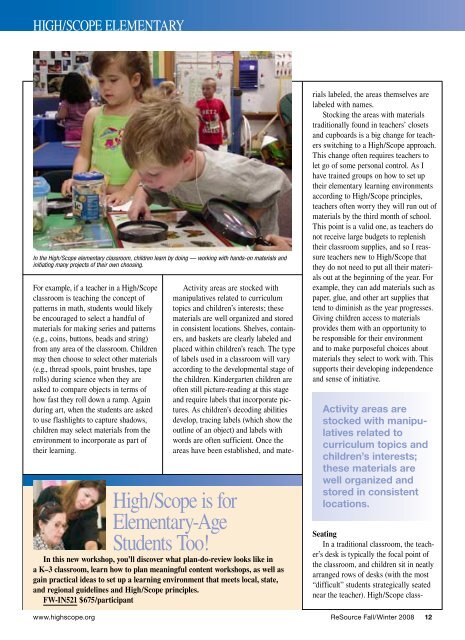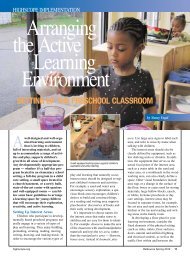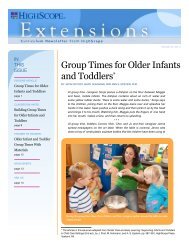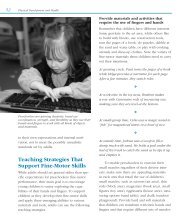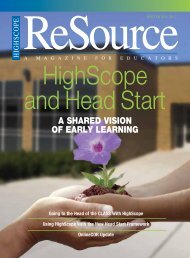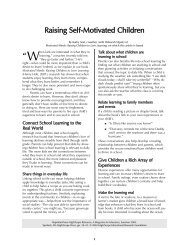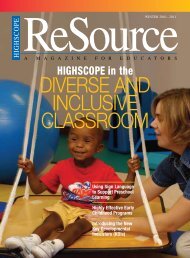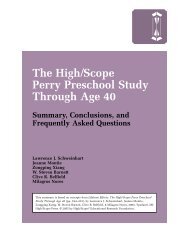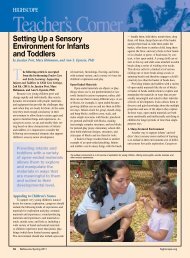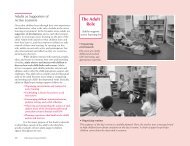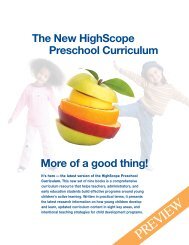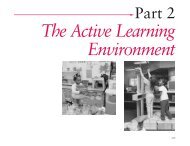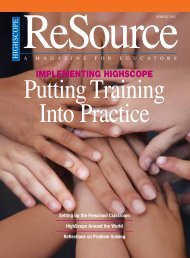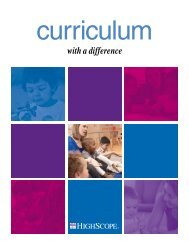Resource - High/scope In The Elementary Classroom
Resource - High/scope In The Elementary Classroom
Resource - High/scope In The Elementary Classroom
You also want an ePaper? Increase the reach of your titles
YUMPU automatically turns print PDFs into web optimized ePapers that Google loves.
HigH/SCoPE ELEMENTARY<br />
<strong>In</strong> the <strong>High</strong>/Scope elementary classroom, children learn by doing — working with hands-on materials and<br />
initiating many projects of their own choosing.<br />
For example, if a teacher in a <strong>High</strong>/Scope<br />
classroom is teaching the concept of<br />
patterns in math, students would likely<br />
be encouraged to select a handful of<br />
materials for making series and patterns<br />
(e.g., coins, buttons, beads and string)<br />
from any area of the classroom. Children<br />
may then choose to select other materials<br />
(e.g., thread spools, paint brushes, tape<br />
rolls) during science when they are<br />
asked to compare objects in terms of<br />
how fast they roll down a ramp. Again<br />
during art, when the students are asked<br />
to use flashlights to capture shadows,<br />
children may select materials from the<br />
environment to incorporate as part of<br />
their learning.<br />
Activity areas are stocked with<br />
manipulatives related to curriculum<br />
topics and children’s interests; these<br />
materials are well organized and stored<br />
in consistent locations. Shelves, containers,<br />
and baskets are clearly labeled and<br />
placed within children’s reach. <strong>The</strong> type<br />
of labels used in a classroom will vary<br />
according to the developmental stage of<br />
the children. Kindergarten children are<br />
often still picture-reading at this stage<br />
and require labels that incorporate pictures.<br />
As children’s decoding abilities<br />
develop, tracing labels (which show the<br />
outline of an object) and labels with<br />
words are often sufficient. once the<br />
areas have been established, and mate-<br />
<strong>High</strong>/Scope is for<br />
<strong>Elementary</strong>-Age<br />
Students Too!<br />
<strong>In</strong> this new workshop, you’ll discover what plan-do-review looks like in<br />
a K–3 classroom, learn how to plan meaningful content workshops, as well as<br />
gain practical ideas to set up a learning environment that meets local, state,<br />
and regional guidelines and <strong>High</strong>/Scope principles.<br />
FW-IN521 $675/participant<br />
rials labeled, the areas themselves are<br />
labeled with names.<br />
Stocking the areas with materials<br />
traditionally found in teachers’ closets<br />
and cupboards is a big change for teachers<br />
switching to a <strong>High</strong>/Scope approach.<br />
This change often requires teachers to<br />
let go of some personal control. As i<br />
have trained groups on how to set up<br />
their elementary learning environments<br />
according to <strong>High</strong>/Scope principles,<br />
teachers often worry they will run out of<br />
materials by the third month of school.<br />
This point is a valid one, as teachers do<br />
not receive large budgets to replenish<br />
their classroom supplies, and so i reassure<br />
teachers new to <strong>High</strong>/Scope that<br />
they do not need to put all their materials<br />
out at the beginning of the year. For<br />
example, they can add materials such as<br />
paper, glue, and other art supplies that<br />
tend to diminish as the year progresses.<br />
giving children access to materials<br />
provides them with an opportunity to<br />
be responsible for their environment<br />
and to make purposeful choices about<br />
materials they select to work with. This<br />
supports their developing independence<br />
and sense of initiative.<br />
Activity areas are<br />
stocked with manipulatives<br />
related to<br />
curriculum topics and<br />
children’s interests;<br />
these materials are<br />
well organized and<br />
stored in consistent<br />
locations.<br />
Seating<br />
in a traditional classroom, the teacher’s<br />
desk is typically the focal point of<br />
the classroom, and children sit in neatly<br />
arranged rows of desks (with the most<br />
“difficult” students strategically seated<br />
near the teacher). <strong>High</strong>/Scope class-<br />
www.high<strong>scope</strong>.org ReSource Fall/Winter 2008 12


